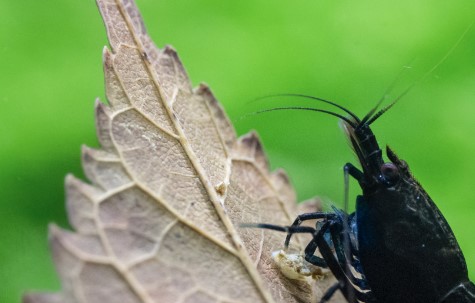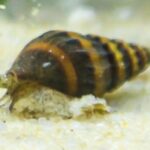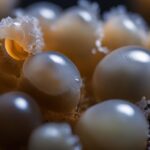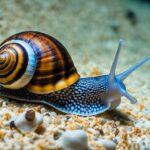The Black Shrimp is an exquisite species of freshwater shrimp, renowned for its captivating coloration. This rare variety of Neocaridina Heteropoda has only been available to aquarists since around 2000, when it was first bred in Taiwan. Possessing a stunning combination of both black and red accents, these shrimp are highly sought-after for their aesthetic value.
Lengthwise, adults reach up to 1.5 inches in size, though they can often be purchased at different sizes ranging between 0.75–1.25 inches. As with most aquarium shrimp, the Black Shrimp boasts a life expectancy between 1–2 years when placed in ideal conditions and given plenty of room to thrive within the tank setup environment. They have become incredibly popular additions to many aquatic habitats over the last two decades; any aquarist looking for an exotic addition would do well to consider this marvelous species!
The difficulty level of this species is easy. They are well adapted to captivity and require relatively little maintenance.
This species is an ideal pet due to its undemanding nature. This species will thrive in modestly sized terrariums as noxious free water quality is not necessary for good health, though they do prefer filtered water. This species hibernates in the winter months and may become inactive when exposed to excessively cold environmental conditions, but generally thrives at room temperature with no extreme temperatures needed.
Lets take a deeper at the Black and Black Rose Shrimp.
Food and Diet
Black shrimp are an interesting and cheerful addition to any fish tank. While their diet may differ slightly, depending on the shrimp species, freshwater dwarf shrimp of all types typically consume the same type of food. To keep them healthy and happy, these shrimp need natural food sources that would usually be found in a well-established aquarium.
This includes biofilm as well as algae which will naturally grow throughout the tank’s hardscape and provide a constant source of sustenance throughout the day. Additionally, it is possible to feed your shrimps with specific store-bought items such as bee pollen, pellets or algae wafers too should you so choose.
It is important for owners to give their shrimps variety within their dietary choices in order for them to get all necessary vitamins and minerals needed for proper growth as well as molting safety. Blanching vegetables from time to time is also recommended in order to add even more variety into their diet. A balanced diet consisting of fresh and dried foods can meet most or all of the dietary requirements for these amazing little creatures but it must be adjusted per species if there are several varieties housed in the same tank.
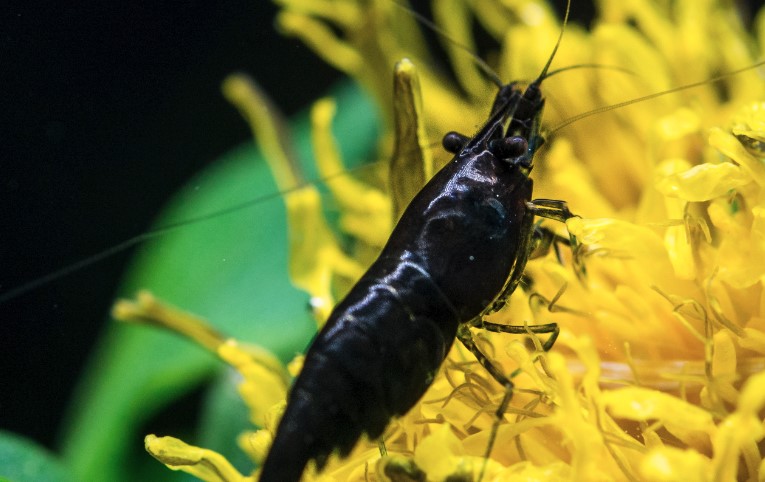
Taking Care of Black Shrimp
With freshwater dwarf shrimp, the Black Rose shrimp is one of the easiest to look after. They are a hardy species and will usually live for 1-2 years in a well maintained tank. The Black Rose can deal with a wide range of water types and parameters, but it’s important not to allow the KH levels to fall below 1 or go above 8, while keeping the GH between 4 and 10 will reduce the risk of any molting issues. They don’t need a heater for warmth unless you live in an area with freezing winters or keep their tank close to a window; however, if you do decide to use one, it’s best to choose a tank size of 10 gallons (38 litres) as it gives greater stability when adjusting water parameters.
How to black shrimp coexist in a tank
These hardy animals can thrive in full freshwater aquariums and tolerate most water parameters that keep their owners happy. Amanos can grow to be slightly larger than their smaller cousins, which makes for a dramatic contrast when placed in the same tank. Their lighter colouring will break up the dark tones of the Black Rose shrimp and make them stand out more in the overall landscape of the aquarium.
When considering other potential tank mates for your Black Rose shrimp, it’s important to remember that there’s no risk of interbreeding with Neocaridina species, since they both require brackish water for raising their young. Popular aquatic snails are usually compatible too, and they’ll appreciate having access to harder water conditions as they’ll receive all of the necessary nutrients needed to develop a healthy shell. When finding tank mates for your Black shrimp, make sure to find those with ideal temperature and pH levels that fit space requirements too! This will ensure each critter invthe tank remains happy and healthy in their home with plenty of room to roam.
Breeding Black Shrimp
When it comes to breeding Neocaridina shrimp, mixing different colours to create hybrids doesn’t always result in a better grade than the parents. Instead, this usually results in babies that are a lower quality version of the parent’s colour. In order to achieve a higher grade of shrimp, a patient and disciplined culling process is necessary. This involves separating any light black colored shrimp into a separate tank, gradually increasing the grade over time. While this process may require patience, there are tips available to expedite the breeding of shrimp.
For example, one tip is to use an all female tank when breeding the females will remain alive until they lay eggs whereas male offspring are born and usually die soon after hatching due to unfortunate genetic traits. Another tip is to carefully source healthy adults for breeding as these adults can pass on their good genetic traits to the offspring resulting in striped or otherwise high quality colourful shrimp patterns faster than if poor quality adults were used. Nevertheless, no matter which methods are used or what tips are followed accurate colour grading and careful culling should be done regularly for ideal colour acquisition results.
Types of Black Shrimp Grades
When considering the grading system of Black, it is important to look at the deep black colour across their bodies and legs. Grade A Black shrimp will have a solid black colour from head to tail, without any lighter or transparent patches. This can make for an impressive display in tanks, with their strong colouration helping them stand out within darker backgrounds. Lower grade shrimp tend to have a more brownish hue that can be similar in appearance to the Chocolate shrimp. In addition, their legs are either mostly translucent or much lighter than their body – indicating that they may not be of the highest grade.
When selecting higher graded Black for breeding purposes, it’s important to pay close attention to both male and female shrimp. Females will normally have stronger colouring compared to males, so you should ensure that your tank has both genders as opposed to automatically removing any shrimp that don’t appear suitable. Even if they may be aesthetically lower grade than the females, males contribute just as much genetically when breeding and should not be overlooked!
Health and Acclimatizing
Since Black shrimp rely on molting to reach adulthood, it is important to monitor their environment closely. The aquarium should have soft sand or peat moss substrate with minimal rocks or other items so that molts can be collected easily. The water quality must also be kept stable to prevent any lingering stress or shock that might slow down their growth or damage the delicate shell during a molt. With proper care and conditions, Black shrimp can develop quickly while still retaining their stunning colors!
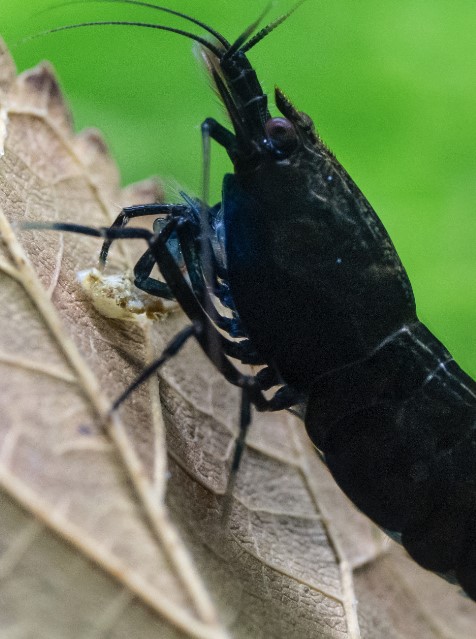
The best way to acclimate Black shrimps to a new environment is by taking your time and introducing them properly. Start by setting aside a container or bucket and float the bag of shrimp in their bag in it for ~20 minutes. This allows the water temperature inside the bag to adjust to the temperature of your tank water. Slowly siphon out half of the water, replacing it with equal amounts of tank water every 5 minutes or so. After 20 minutes have passed, you can use a net to gradually add your shrimps into the tank one at a time.
Black Rose Shrimp are deep black in color and will lose their color if kept on light substrate, as they rely on camouflage to protect themselves from predators. This means that choosing a dark substrate will allow them to blend in better with their surroundings and have more protection against danger.
Additionally, because they’re such small animals, they don’t prefer larger particles of substrate; it’s best to go with something smaller like aquarium sand or gravel that won’t cause damage to their delicate bodies. Furthermore, some aquarists have had luck with not even having any type of substrate at all so it may be worth mentioning that alternative as well. Ultimately, the decision comes down to personal preference and what works best for your tank environment, but either way dark substrate is the ideal option for keeping your Black Rose Shrimp safe and healthy!
In terms of how many these creatures you can keep in a single gallon, the answer is almost limitless. As long as you start with at least a 5-gallon tank, you should be able to sustain an ample amount of Black Rose shrimp without overcrowding the space. With proper maintenance and adjustments when needed, your colony will soon strike a balance where each member has enough room to thrive.
One crucial factor that impacts the number of fish or shrimp in an aquarium is filtration and water quality. To ensure that water parameters remain high enough for them to survive, a filter would be necessary when stocking large amounts of Black Rose shrimp. Additionally, frequent water changes should be done on occasion to prevent nitrate build up due to excess waste produced by these invertebrates. Allowing dirty water to remain stagnant can lead to health complications within the tank so do make sure you monitor levels regularly and provide sufficient nutrients for them. With proper care they are sure to reward you with lively activity and vibrancy within your aquarium!
Color Change
Having a Black Rose shrimp in your aquarium can be quite stunning, as they introduce beautiful blacks, reds and oranges into your tank. But sometimes you may notice that the colors of your Black Rose shrimp have started to fade. This could be due to a variety of factors, and it is important to discover why so that you can take the necessary steps to preserve the vibrant colors of your shrimp.
The quality of the water in your tank is one possible reason for black rose shrimp losing their coloration. To test this, you can pick up an aquatic life test kit from our shop which will measure pH levels, ammonia levels and other parameters in order to ensure that water conditions are suitable for these animals. If the water quality isn’t up to par, then this could lead to fading colors in black rose shrimp or other aquatic species.
Additionally, it is also recommended to keep them on a darker substrate such as aquarium gravel or sand as this helps them blend into their environment and reduces any fading due to light exposure. If either of these factors don’t match ideal requirements, then it’s likely that you’ll need to take action if you want the captivating colors of your black rose shrimp back.
Behaviour
Black Rose Shrimp are a peaceful and active freshwater species that can be kept in aquariums and make for great companions for other types of fish. They are very alert and active in their habitat, often seen grazing on any algae they can find around aquarium plants, decorations, or on the substrate. When fed, these shrimp have quite an amazing behavior as they form into large groups which give them an undeniably beautiful appearance when viewed up close.
Conclusions
Black Rose Shrimp are an incredibly beautiful freshwater species that can be kept in aquariums. They require proper care and maintenance to keep them healthy and vibrant. It is important to provide them with a dark substrate, regular water changes, and test the water quality regularly for optimal health. Color change may occur due to poor water quality or too much light exposure, so it is important to take steps to prevent this from happening. With proper care Black Rose Shrimp can make for a great addition to your Aquarium!
Please reach out if you need any assistance or have any further questions. More than happy to help.

